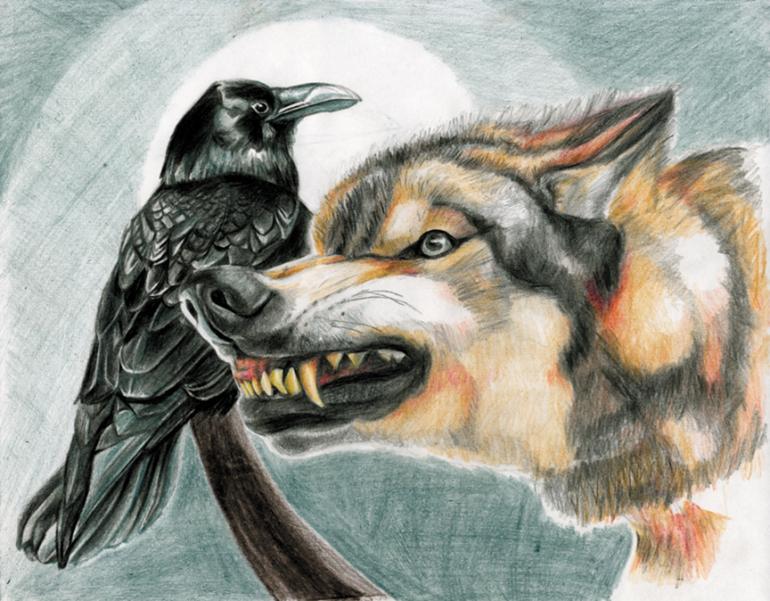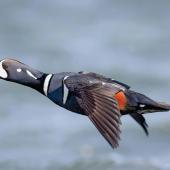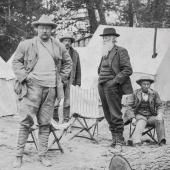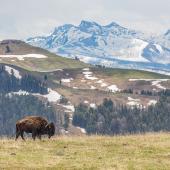Wolf & Raven
Partners in time.
Driving through the milky dawn twilight, the hills and forest of the Lamar Valley in Yellowstone National Park begin to materialize. The air flowing over the vehicle seems to almost crackle with the intense cold. I started this drive in pitch-black darkness, coming to this place in search of one of the spectacles of the northern Rockies: the gray wolf roaming wild and free in an essentially unaltered environment.
Pulling into a turnout at the Specimen Ridge trailhead, I get out of the vehicle to face the brute force of Yellowstone spring weather for the first time. It is the type of cold that burns your nose and sucks the wind out of your lungs. The frigid air slices through the wool and synthetic fibers of my clothing with the ease of a needle through cloth. This cold does not seem to affect the wolves and ravens. They, in fact, thrive in these harsh conditions. These creatures are perfectly suited for the climate of Yellowstone’s northern range.
With a semi-frozen ear, I hear the mournful howl of a distant wolf cascade over the sparsely vegetated rolling hills. It is a liquid sound that seems to flow with an incessant momentum. The howl of a wolf brings up many primordial feelings for some people—the fear of the unknown and the dread of being in the presence of a skilled and cunning predator. The sense of wilderness and kinship arises for others, creating a conflict in the human heart and mind. The former may be more common than the latter; the wolf is the very essence of wildness to many of us.
Another sound quickly accompanies the howl of the far-off wolf: the hoarse call of the common raven. Its large, jet-black body is a common sight just about everywhere in Montana, from the streets of town to the high alpine and everywhere in between—yet it is here, in the wildlife-rich landscape of Yellowstone, that its importance resonates with me, as an icon of wildness and the dynamic among the wild creatures of the northern Rockies.
The raven and the wolf seem to coexist with a certain sense of harmony and understanding. The predator rovides scavenging opportunities for the bird, and the bird may be welcome company on the coldest of nights.
The relationship between the wolf and raven is the stuff of myths and legends for Native Americans and other groups around the world. Both Raven and Wolf were important spiritual figures to these cultures. Among the Norse, to see a wolf and raven together was a good omen for success in an upcoming battle. The Cree use the relationship between wolves and ravens to explain the creation of the earth: “When all the land was covered with water, the trickster Wisagatcak pulled up some trees and made a raft. On it, he collected many kinds of animals swimming in the waters. The Raven left the raft, flying for a whole day, and saw no land, so Wisagatcak called Wolf to help. Wolf ran around and around the raft with a ball of moss in his mouth. The moss grew, and earth formed on it. It spread on the raft and kept on growing until it made the whole world. This is how the Earth was created.”
The wolves have killed a cow during the night, and its half-eaten carcass is lying in a brushy gully. There are three sets of wolf tracks alongside the cow’s, where she crashed through the snowdrift. The wolves dragged her down by the haunches and delivered the deathblow by ripping out her throat. They filled their bellies until the distant sun began to lighten the eastern horizon. The wolves then retreated into the nearby timber.
Gazing across the valley, I occasionally glimpse one of the younger wolves moving amid the trees. Standing atop the carcass, a large raven picks chunks of meat from the rapidly freezing body. Other ravens and black-billed magpies soon join it. These scavengers have sought out this kill from some distance away. Watching the ravens, I wonder if the black birds witnessed the hunt that took place the previous night. Did a large raven, silhouetted against the moon, maintain a watch on the life-and-death struggle, and hope for death? A shy coyote has joined the mob at the carcass. It acts like a scolded child, as it smells the wolves at the kill. It quickly rips off a mouthful and retreats to a safe distance. The small coyote knows if the nearby wolves catch it at their kill, it will mean a quick, violent death from the crushing jaws of its larger canine cousins.
By the late afternoon, the light is fading and the wolves are rising. They make ready for another night’s hunt. A couple of the younger wolves come down to the carcass for a snack. As they approach, the magpies flush in a cacophony of harsh calls. Ravens launch up into the air and circle around—except for one that’s perched on the exposed limb of a dead Douglas fir. It watches intently as the pair rips bits of frozen muscle from the elk’s body. The bird seems to be almost studying the wolves, trying to learn more about their habits. The pair of wolves turn and lope up the sage-covered hill to rejoin the pack. With a series of howls and other vocalizations, the entire pack trots off for the night’s hunt. The raven takes flight and follows the pack’s path. The companions are together again for the hunt.
Spring Birding: Catch the fever (and we're not talking about bird flu)
It may not be your typical spring fever, but it's the fever birders love to catch. They're anxious to hit the trails, highways, lakes, even their backyards, with a good pair of binoculars. If you're a beginning birder and are looking for the right binoculars, I’d recommend an 8-power pair (8 times the normal image size). Higher-power lenses, such as 10, tend to reveal an irritating "hand-shake" phenomenon. I like 8x40 binoculars (the "40" is the diameter of the bigger, or objective, lenses in millimeters; they give you a wider field of view and produce a brighter, clearer image than smaller lenses).
According to John Parker, Bozeman's birdman extraordinaire, the first influx of migrating species takes place the first week in March. That's when pintails, horned larks, mountain bluebirds, rosy finches, and robins touch down in the Gallatin Valley (for a complete list of incoming species and dates of arrival, talk to Dave Mann at Wild Birds Unlimited; he also carries binoculars, spotting scopes, and birding hotspot maps).
Some of the best local places to bird include Lindley Park and the adjoining Sunset Hills cemetery, Kirk Hill, the Sourdough nature tail, Central Park Pond (off the frontage road between Belgrade and Manhattan), East Gallatin Recreation Area, the Fish Technology Center, and the "M" trail.
For more information on rare species spotted locally, guided bird walks, and other spring birding activities, call the rare-bird hotline at 406-721-9799, log on to mtaudubon.org, or stop in at Wild Birds Unlimited.
—Bruce Moseley











